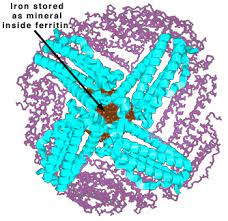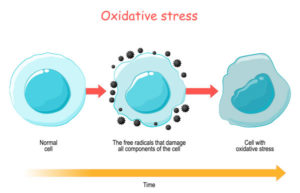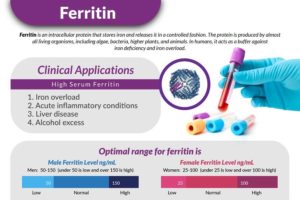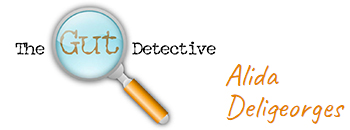When people think of iron levels, they usually associate fatigue, dizziness and shortness of breath as the main symptoms. Simply examining your iron levels however may not show the entire picture, especially if your iron reading falls within the normal reference range.
So what do we need to look at for a more exact picture of what is happening in our bodies when it comes to iron levels?
Think of your body as a kitchen pantry. Most of it is stocked with food you use every day. But you keep some items in there long-term – an extra packet of pasta or can of beans to have on hand when supplies get low.
Your body stores iron the same way. It uses some of the iron it gets from food right away to make oxygen in your blood. But it also keeps some iron on hand for times when you aren’t getting enough from the food you eat.
The iron is stored as ferritin – a major player in overall health.
What is Ferritin?
Ferritin is an iron-containing protein and is the main form of iron stored inside your cells. Even though there is a small amount of ferritin released into your bloodstream, it is an accurate marker of how much iron is actually stored in your body. Iron is primarily stored in your liver, muscles, spleen, and bone marrow but if you have too much it can accumulate in your organs and the brain.

You either have too much iron, too little, or just the right balance in your body and the ferritin test can give us an excellent picture of how much iron is actually stored in your body. Iron is found in your red blood cells but it also accumulates in your organs and tissues.

Iron is important for healthy oxygen transport throughout your body so you can see how vital it really is for your health. Too little iron will result in anaemia which basically means that your red blood cells cannot carry enough oxygen to your cells and you start to develop signs of oxygen deficiency.
Signs of Anaemia Include:
– Weakness
– Dizziness
– Headaches
– Pale skin
– Fatigue
– Low body temperature
– Memory loss
– Hair loss
– Poor brain function
– Hypothyroidism
– Adrenal fatigue
– Spoon-shaped finger and toenails
– Smooth tongue
– Burning sensation in the tongue
– Sores at the corners of the mouth
– Dry skin
– Shortness of breath
– Ringing in the ears (tinnitus)
– Leg pains
– Chest pain
– Pica (cravings for specific substances, such as ice, licorice, chalk, dirt, or clay)
Too much iron can have the opposite effect because iron creates a lot of oxidative stress which is basically too many free radicals that create cell damage and inflammation. These free radicals also eat up your antioxidants like vitamin C and E creating deficiencies.

Menstruating females lose a small amount of iron every month during their cycle so they tend not to build up too much iron in their bodies. However, iron levels can get too low when your diet is deficient in iron and you have absorption issues due to things like gluten and gut infections. Low ferritin levels are noted in chronically-ill women who are still cycling but it is also common in postmenopausal women who never restored their iron levels before entering menopause.
Since men do not have a menstrual cycle, they are the most at risk for accumulating iron. As iron builds up in a man’s body he may develop the following symptoms as it accumulates in the brain and other body tissues (most of these also apply to women):
– Brain fog
– Fatigue
– Low sex drive and erectile dysfunction (iron accumulates in the testicles)
– Mood swings, especially anger
– Digestive problems as iron builds up in the gut
– Anxiety
– Depression
– Fatigue after meals (insulin resistance)
– Memory loss
– Joint pain
– Weight loss
– Abdominal pain
– Hair loss
– Congestive heart failure
Iron is extremely heavy in the bloodstream so it forces the heart to work harder as it pumps this heavy metal through your blood vessels resulting in blood pressure changes and more inflammation in your arteries.
This is where the ferritin test is so important because it can tell us if there is too much or too little iron in your body. It’s a simple blood test that a doctor can order as part of an iron studies pathology test.
What Should You Do If Your Iron Levels Are Too Low?
One extremely important fact to note is that your iron levels can become depleted due to internal bleeding from serious diseases such as cancer, an ulcer in your gut or more commonly excessive menstrual bleeding. If you or your doctor suspects a serious disease or condition, then you should be evaluated by a specialist to rule out something more serious.
If your iron is simply low due to insufficient dietary intake or absorption problems then you can begin to take the following steps to restore your levels:
- Iron supplementation. Iron is best taken in a chelated form (such as iron glycinate) with food for the best absorption. Combining iron with vitamin C will help its absorption.
- You may require intravenous or iron injections if your ferritin levels are extremely low.
- Identify food sensitivities such as gluten which can create absorption problems.
- Get your thyroid checked since low thyroid function results in low stomach acid which will negatively affect the absorption of vitamins and minerals.
- A stool analysis may be in order to identify infections such as parasites, bacteria, or yeasts that can also create poor absorption. In fact, some parasites such as worms feed on iron and b-vitamins resulting in deficiencies.
- Increase your consumption of iron-rich foods. Iron is found in the diet in two forms – heme iron, which is well absorbed, and nonheme iron, which is poorly absorbed. The best dietary source of absorbable (heme) iron is lean red meat. Chicken, turkey, and fish are also sources of iron, but they contain less than red meat. Cereals, beans, and some vegetables contain poorly absorbed (nonheme) iron. Foods rich in vitamin C (e.g., citrus fruits and fresh vegetables), eaten with small amounts of heme iron-containing foods, such as meat, may increase the amount of nonheme iron absorbed from cereals, beans, and other vegetables. Some foods (e.g., milk, eggs, spinach, fibre-containing, coffee, tea) may decrease the amount of nonheme iron absorbed from foods. Additional iron may be added to food from cooking in cast iron pots.
Additionally, you may want to limit your consumption of the following which inhibit the absorption of iron (these can be used if your iron is too high as a treatment strategy):
- Calcium supplements and calcium-rich foods
- Eggs
- Phytates: Reduce iron absorption by about 50% (nuts, seeds, legumes, cereals, whole grains). Proper preparation of these foods such as soaking and sprouting significantly reduces the phytate content.
- Oxalates: spinach, kale, beets, nuts, chocolate, tea, wheat bran, rhubarb, strawberries, and herbs such as oregano, basil, and parsley.
- Polyphenols: cocoa, coffee, black tea, green tea, berries, walnuts, apples.
All of these items above need to be taken 2 hours away from iron supplementation in order to ensure iron absorption will not be affected.
If you have too much iron in your body then you may have a genetic condition known as hemochromatosis. This disease basically means that your body is absorbing too much iron so it builds up in massive quantities. It can be deadly if not found early as iron continues to build resulting in heart attack and organ failure. Hemochromatosis is handled by a gastroenterologist or haematologist who will have you do frequent therapeutic phlebotomies to reduce your iron levels. This usually works quite nicely to get iron levels down to a healthy level and then you must be monitored and prescribed a schedule for regular phlebotomies or blood donations to keep your iron levels in a healthy range.
Additionally, there are a few things you can do to keep your iron levels low and reduce the oxidative stress from the excess iron:
- Drink green tea. This will inhibit iron absorption and the antioxidants in green tea will help reduce inflammation.
- Increase consumption of the spice turmeric or supplement with curcumin. This has actually been shown to help your body get rid of excess iron.
- Stop cooking on iron cookware (such as cast iron) which can result in iron in your cooked food.
- Decrease consumption of foods that are high in iron. Red meat has the highest level of iron which is great if your iron levels are low, but not so great if they are too high.
- Be careful with vitamin C supplements since vitamin C improves the absorption of iron. Some say the antioxidant effects of vitamin C cancel out the negative effect of increased iron absorption, but I recommend just not going overboard if you are going to take it.
- Avoid alcohol, sugar, nicotine, and beta-carotene which all increase the absorption of iron.
Iron and Your Thyroid
Too much iron can build up in your thyroid gland creating inflammation and imbalanced hormone production. However, iron is required for thyroid hormone production, the conversion of T4 into the more active T3, and for utilization of thyroid hormone in the cell, so your ferritin levels must be healthy for optimal thyroid hormone levels. I have found that low ferritin levels (<90μg/L) have been the missing link in some patients with hypothyroidism who just can’t seem to get their thyroid levels in balance. If you have a thyroid problem, definitely have your ferritin levels checked to make sure your ferritin is not too high or too low.
Iron At War?
Too much iron can create an internal battle between iron and the following nutrients:
- Zinc
- Manganese
- Molybdenum
- Copper
As iron accumulates in your body, you may develop deficiencies in these vital nutrients which are key factors in hundreds of processes in your body. Just as iron competes with these 4 nutrients, they also compete with each other so it’s a matter of finding the right balance, separating the doses by several hours (usually 2 hours apart is enough) and not taking too much of one of these for long periods of time so you don’t develop deficiencies.
What Is a Healthy Ferritin Level?
Standard lab ranges are pretty broad currently set at 15-150 μg/L for adult women and 30-400 μg/L for adult men. I prefer ferritin of about 90-110 for optimal health for women and between 90-150 for men. Some women need to have ferritin at 100 or above just to start seeing hair regrowth, to normalize thyroid function, and to really feel better. It’s amazing how symptoms can set in when the ferritin drops below 100.

Are There Other Tests You Should Have?
You should also have these iron values tested along with ferritin to get a more accurate picture:
- Serum iron
- % iron saturation
- TIBC (Total iron binding capacity)

If you only check ferritin without the above three markers then you’re not getting the complete picture. If the above markers are elevated along with normal or low ferritin, then it most likely isn’t a good idea to supplement with iron. If the above three are elevated then your blood and cells are saturated with iron and it isn’t being used properly by your body. This could be due to liver dysfunction, hypothyroidism, vitamin B12, or folate deficiency. You don’t want to dump more iron into a system that is overly saturated.
If however the % iron saturation and TIBC are low and your serum iron is normal or low along with low ferritin, then it can be safe to start supplementing with iron. Have these levels checked every 6 weeks until all your markers normalize.
The ferritin test is by far one of the most important tests you can have done on a regular basis yet it is almost never ordered by conventional doctors. Make sure you request it the next time you have a check-up. It just may be the missing link if you aren’t feeling your best.
Don’t Self-Diagnose Iron Deficiency
Since iron supplements are available without a prescription, it can be tempting to self-diagnose, but this is not recommended because:
- Having too much iron in the body can be toxic and even fatal.
- Fatigue, paleness, dizziness and breathlessness are symptoms of many other health conditions, not just iron deficiency anaemia. Some of these other conditions are serious. Incorrectly self-diagnosing and self-medicating can be dangerous and can waste valuable time in getting the treatment you need. Getting the right treatment in the early stages of a disease offers a greater chance of recovery. So always visit your doctor if you think you could be iron deficient.
- Iron supplements won’t help the symptoms if iron deficiency anaemia isn’t the problem.
- Taking an iron supplement when you don’t need it can interfere with your body’s absorption of other minerals, including zinc and copper.
- About one in 300 people have haemochromatosis, which is an inherited condition that prompts the body to absorb more iron than usual. Excess iron damages the body’s tissues and increases the risk of cancers and heart disease. People with haemochromatosis need to limit how much iron they consume.
CLICK HERE to book a consult online.
**If you’ve got this far – thank you for reading and I look forward to bringing you more information in the future.
Enjoy a wonderful educational video on IRON PHYSIOLOGY by Armando Hasudungan …

